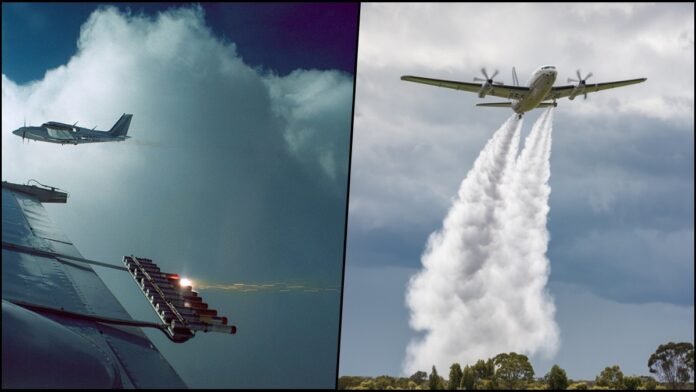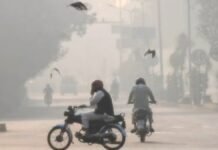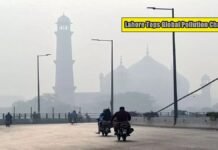
Key Points:
- Delhi’s overall AQI improved to 293 (“poor” category) on October 23, 2025, after touching 429 (“severe”) post-Diwali on October 21
- Anand Vihar recorded AQI of 403 in “severe” category, while 15 other locations remained in “very poor” zone above 300
- Cloud seeding experiment scheduled for October 29, 2025, using Cessna aircraft deployed from IIT Kanpur
- PM2.5 levels reached 228 micrograms per cubic meter on October 21-15 times WHO’s safe limit
- Pyrotechnic flares containing silver iodide will be released under clouds within 72-hour window if conditions favorable
- Cloud seeding effects expected within 100-kilometer radius covering entire Delhi-NCR region
- Previous Kejriwal government had approved similar IIT Kanpur project in 2020 but failed to implement
New Delhi: Delhi’s air quality plummeted to hazardous levels following Diwali celebrations on October 20-21, 2025, with the capital recording the worst air quality among major global cities. On October 21 at 6 AM, PM2.5 concentrations reached 228 micrograms per cubic meter 15 times the World Health Organization’s 24-hour safety limit of 15 micrograms per cubic meter. By 9 AM, the 24-hour average Air Quality Index touched 356 in the “very poor” category, with monitoring stations at Bawana, Burari, Jahangirpuri, and Wazirpur reporting “severe” levels exceeding 400. Swiss air quality technology firm IQAir recorded Delhi’s AQI at 442, positioning it as the most polluted major city worldwide, with PM2.5 concentrations over 59 times the WHO’s annual guideline.
The pollution spike was attributed to widespread violations of Supreme Court restrictions that limited firecracker use to 8-10 PM with only “green crackers” permitted. PM2.5 levels surged from 150 micrograms per cubic meter at 4 PM on October 20 to nearly 650 by 11 PM, coinciding with peak firecracker activity. Despite mandates for green firecrackers with 30% less emissions, enforcement remained inadequate, with non-green firecrackers widely available and used beyond permitted hours.
Current Pollution Status
As of October 23, 2025, Delhi’s overall AQI showed improvement to 293 in the “poor” category, marking a significant recovery from post-Diwali “severe” levels. However, pollution distribution across the capital remained highly uneven. Anand Vihar recorded the worst AQI at 403 in the “severe” category. Fifteen monitoring stations remained in the “very poor” category (301-400), including Ashok Vihar (322), Bawana (348), Burari Crossing (335), Jahangirpuri (350), ITO (316), Nehru Nagar (314), Patparganj (324), Punjabi Bagh (313), Vivek Vihar (346), and Wazirpur (337).
Eighteen areas showed improvement to the “poor” category (201-300), including Alipur (285), DTU (244), Dwarka Sector-8 (290), IGI Airport (257), Mundka (280), Najafgarh (206), and Okhla Phase-2 (296). Lodhi Road recorded the best air quality at 198 AQI in the “moderate” category. In NCR cities, Noida registered 264, Greater Noida 272, Ghaziabad 273, and Gurgaon 208, while Faridabad improved to “moderate” at 198.
Historic Cloud Seeding Operation
The Delhi government has scheduled India’s first cloud seeding operation in the national capital for October 29, 2025, marking a technologically historic initiative to combat air pollution. A specialized Cessna aircraft from IIT Kanpur has been deployed to Meerut, positioning for the experiment that can be conducted within a 72-hour operational window, subject to favorable meteorological conditions. This represents the culmination of efforts that began when the previous Kejriwal government approved a similar IIT Kanpur project, which remained unimplemented due to logistical and atmospheric constraints.
Cloud Seeding Technology
Cloud seeding employs scientific weather modification techniques to induce artificial precipitation. The Cessna aircraft carries eight to ten pyrotechnic flares mounted under both wings, each containing silver iodide, dry ice, and salt compounds. When atmospheric conditions are suitable, requiring cloud cover with at least 40% moisture content, pilots activate these flares by remote button, ejecting chemicals that react with cloud formations from bottom upward. Silver iodide particles serve as nucleation agents, causing microscopic water droplets to condense around them and aggregate into larger droplets heavy enough to fall as precipitation.
The pyrotechnic flares create a chemical reaction that increases condensation rates within clouds, transforming water vapor into liquid precipitation. The effectiveness of this method depends critically on existing atmospheric moisture and cloud density, making it impossible to generate rain from clear skies. Scientists estimate the pollution-reducing effects will extend approximately 100 kilometers from the seeding location, potentially covering the entire Delhi-NCR region.
Historical Precedents in India
Cloud seeding is not unprecedented in India, with experiments conducted since 1951. The first Indian attempt occurred in 1951 when a Tata firm deployed ground-based silver iodide generators in the Western Ghats mountain range. Subsequent operations have been conducted in Karnataka (2003, 2004, 2019), Maharashtra (2004), Andhra Pradesh (2008), and Tamil Nadu on three occasions, primarily to combat drought conditions rather than pollution. The Indian Institute of Tropical Meteorology has confirmed these operations, noting that weather modification technology has evolved significantly since the world’s first successful experiment conducted by the United States in 1946.
Health and Environmental Impact
The sustained exposure to severe air pollution poses critical health risks for Delhi’s approximately 20 million residents. PM2.5 particles, measuring 2.5 microns or smaller, penetrate deep into lung tissue and enter the bloodstream, causing respiratory diseases, cardiovascular conditions, and premature mortality. The WHO guidelines recommend annual average PM2.5 concentrations not exceeding 5 micrograms per cubic meter, yet Delhi regularly records levels 40-60 times higher during the winter months. In 2025, zero percent of the 296 days through October fell within the WHO’s safe air quality limits, creating extreme health risks, particularly for children, elderly populations, and individuals with pre-existing respiratory or cardiac conditions.
Seasonal Pollution Factors
Delhi experiences particularly acute air quality deterioration during the winter months due to multiple converging factors. Stubble burning by millions of farmers in neighboring Punjab and Haryana states contributes massive quantities of smoke and particulate matter as agricultural waste from rice harvests is cleared for wheat cultivation. Temperature inversions trap pollutants close to ground level, while stagnant wind conditions prevent dispersion. Vehicle emissions, industrial discharge, construction dust, and domestic heating sources compound the crisis. The Ministry of Earth Sciences has predicted that Delhi’s air quality will remain in the “very poor to poor” range with AQI fluctuating between 201-400 in the coming weeks without significant meteorological changes or intervention.




















































